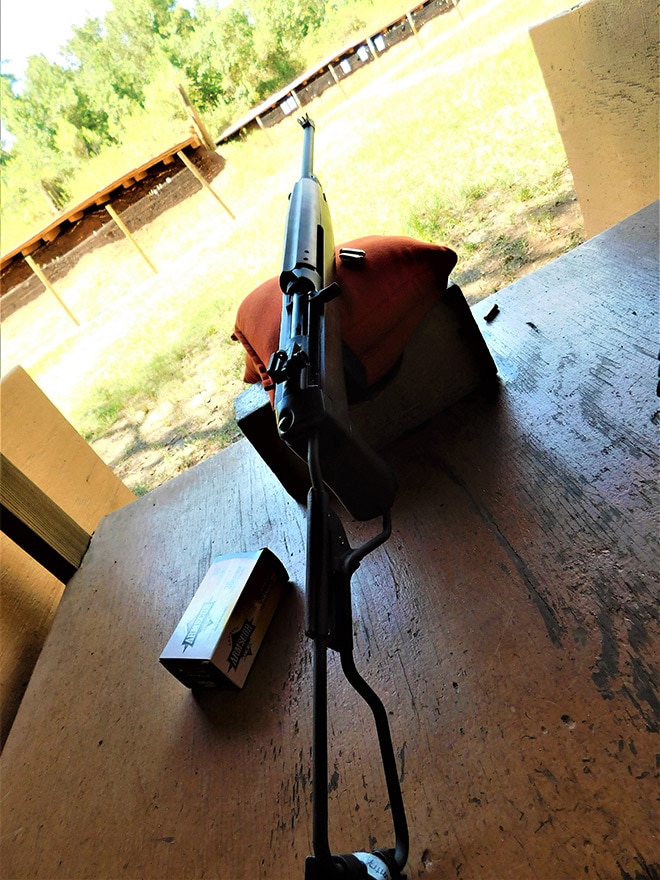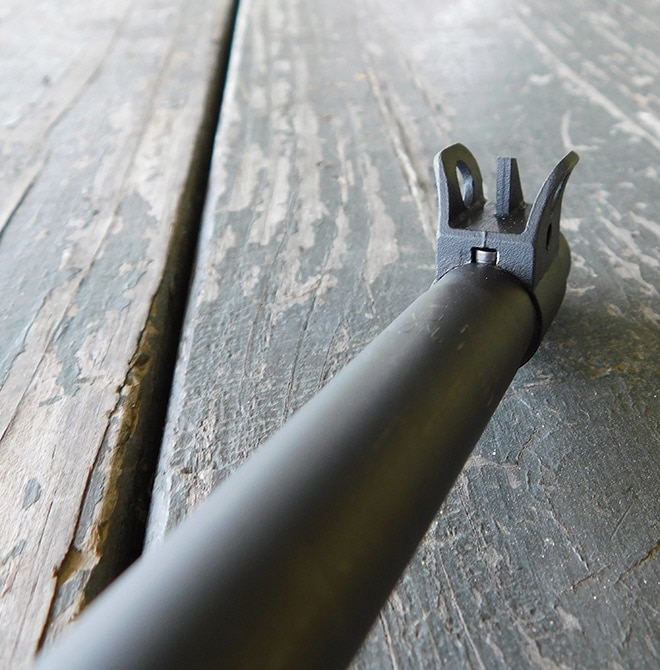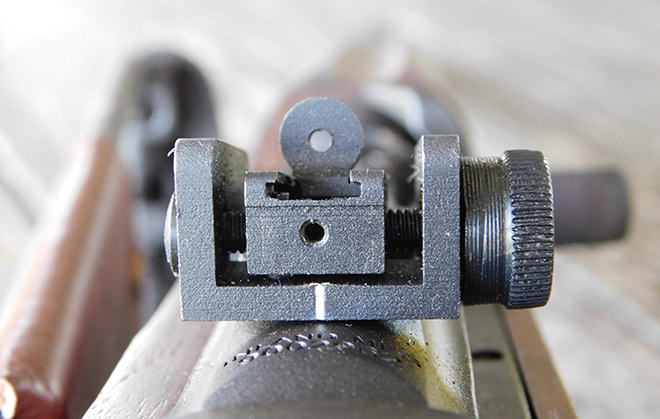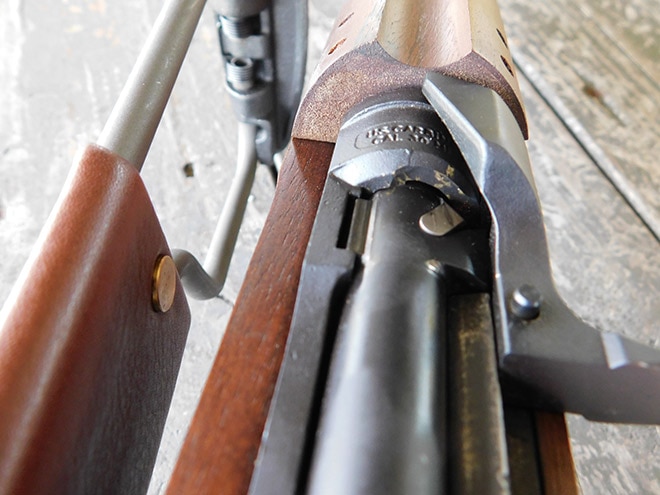
The author takes aim with the new Inland Paratrooper Carbine. (Photo: Terril Herbert)
During World War II, Inland — then a division of General Motors — stepped up to support the American war effort by manufacturing one of the first true personal defense weapons ever fielded, the M1 Carbine.
The M1 Carbine was meant to be a light rifle used by troops whose main duties weren’t fighting on the front lines. Support troops like truck drivers, mortar crews, and the like were relatively safe in previous wars but World War II was no ordinary conflict. German tactical doctrine at the time emphasized breaking through and cutting off the enemy while avoiding strong points. The fearsome Fallschirmjager was also a threat, jumping out of perfectly good airplanes to seize key positions — and target personnel far behind enemy lines.
It was clear that in the coming conflict, we needed a weapon with greater firepower and range than what a M1911 45 caliber pistol could offer. But these troops couldn’t lug around a 9-pound M1 Garand. The 5-pound M1 Carbine firing an intermediate power 30-caliber cartridge seemed well suited for the job.
In all, Inland produced over 2.5 million of them, nearly half of the total production by the time the war ended in 1945. They also produced a model with a folding stock for use by paratroopers, designated the M1A1.

The M1A1 Paratrooper was a rare bird during World War II and it gave unrivaled compactness and good firepower for its time. Today, the folding wire stock seems a little cheeky. (Photo: Terril Herbert)
The M1 Carbine was both loved and hated by the people who used them, yet all told the gun seems to have served well. Today, some of the US’s allies, like the Philippines, are still fielding the M1 Carbine. The little gun, with complaints and all, has had a remarkable service life despite never being remotely considered a standard issue rifle. Here in the States, the M1 Carbine is every bit Americana as baseball and the 1911 pistol.
Commercially, the American love of this higher capacity “mini Garand” has never lost steam. A relatively recent entry in the M1 Carbine repro market is the new Inland Manufacturing company based out of Dayton, Ohio. They offer newly manufactured M1 Carbines, m1911 pistols, and the m37 Trench Shotgun. These new M1 reproductions appealed to me since I could have a brand-new firearm with a historic pedigree that I wouldn’t feel bad about shooting. World War II era carbines are excellent investments, but I would hate to beat up or wear out the real thing.
Unfortunately, throughout the years, M1 repros have run the gamut from great to terrible. Inland’s gun falls in the latter category.
Inland’s M1A1 Paratrooper
I decided I wanted to get my hands-on Inland’s M1A1 paratrooper as it is a variant of the M1 Carbine that doesn’t get much attention. Indeed, relatively few of these were produced during the war, so it wouldn’t warrant that much attention. But in today’s emphasis on compactness (25.75 inches folded, 35.75 inches overall, 5.188 pounds), the M1A1 has some practical vintage appeal.

The folding wire stock is not lefty friendly, but it is not supposed to be. (Photo: Terril Herbert)
At first glance, the M1A1 Paratrooper looks great. The walnut stock as well as all the steel parts, treated in a nice, grey parkerized finish, have immediate appeal. It has prominent cartouche markings and the appropriate designation stampings on the receiver. The receiver is cast steel, not forged like on the originals, but cast technology of today is quite proven in terms of strength and durability. It certainly had no bearing on the smoothness of the action, which felt mechanical yet smooth without any perceived dragging as the rotating bolt unlocks, comes back, and then goes forward to lock into place again.
The buttstock is made of thick, steel wire with a folding metal buttplate hinged at the end and a protective leather cheek rest in the middle of the stock on the left side. The stock folds out of the way and snaps locked in place by simply swinging it out until it clicks into place.

The rear sight peep is easily adjustable—whether you want to adjust it or not. (Photo: Terril Herbert)
The rifle is, of course, semi-automatic and uses a short stroke gas system just like the originals. An early war push button safety rests at the bottom of the trigger guard next to the push-button magazine release. Speaking of magazines, Inland’s gun comes with one magazine that holds 15 rounds of 30 Carbine ammo. The sights consist of a protected post front sight and a late-war style sliding aperture rear sight that runs from 100 to 300 yards and is adjustable for windage via a knurled dial on the right side. An elaborate set-up, considering the 18-inch barrel and the relatively low powered cartridge involved.
With such a handy package, I looked forward to hitting the range. There, the problems began.

The new Inland M1A1 at the bench. (Photo: Terril Herbert)
On the range
I headed off to the range with my first 100 rounds of ammunition determined to do an ammo dump to test reliability before settling down with my last few rounds for groups and measuring velocity with the chronograph.
My test ammunition was PPU 30 Carbine 110 grain full metal jacket ammunition with Filipino made Armscor 110 grain rounds of the same type to round out the test. The round is neat, with its straight-wall case. Much like a revolver case, except it’s rimless like a good rifle round. It was my first time seeing or shooting the 30 Carbine round. I exhibited a giggle as I loaded the magazine with a clean target out at 25 yards. I didn’t bother to get more magazines at the time, so this one would have to do. It loaded like butter and the stamped steel didn’t dig into my hands — something I can’t say for sure about other firearm magazines.

Between my initial test ammunition, the Armscor fodder suffered more than the PPU ammunition, but none did well. This was the most common malfunction, followed by out-right failures to extract. (Photo: Terril Herbert)
With the magazine loaded, I pushed it into the magazine well and slapped it hard to seat it on the closed bolt. I racked the bolt smartly and let it fly forward with a satisfying metallic clink. With the sights set at the lowest setting, 100 yards, I stood up, took aim, and proceeded to blast away. Then the problems started.
The wooden handguard in front of the action effectively constricts my line of sight and the wood is cropped up far too high on the left side, which makes the already low sight picture even harder to read. The front post was effectively half buried in wood. Even so, I pressed on and fired the first shot. It popped with authority, but without much recoil at all. I pulled the trigger again—nothing. I looked up and saw the gun had ejected the first round and tried to feed the second but the first case was stuck lengthwise between the bolt and the chamber. I plucked the case and continued.

The front sight is great and very hard to knock, but it is simply too hard to see. (Photo: Terril Herbert)
As I shot, I noticed the recoil didn’t come to the shoulder, but to the cheek after multiple rounds. That wire stock was not great in World War II and it isn’t great now. On the seventh round, an empty case jammed in the same way. I decided to switch to my reserve Armscor ammunition, but that only made the problem worse.
In the first magazine of Armscor, three cases refused to extract causing the next round to feed into the empty case — double feeds. I had to work the magazine release hard to pull the magazine out and clear the jam. The malfunctions continued as I cleared the box of Armscor ammo. A total of 12 of 50 shots resulted in malfunction. I was left with half a box of my PPU ammunition, which seemed less problematic, to do my accuracy testing.
I was sure that the malfunctions could eventually be fixed, but it would be nice to sit down, calm down, and fire some groups.
When I went to the bench, I found that the range increment reader at the back of the rear sight — held in place by a small set screw — had fallen off. The rear sight had also magically moved to the 300-yard setting. After a bit of research, I found that this late war sight was criticized for being too easy to move out of position by inadvertently bumping it. But already in the first volley, I was missing pieces off the rifle.

Almost immediately you can see a piece missing. And that peep is cranked over very far to the right. (Photo: Terril Herbert)
At 50 yards, the sights were well off to the low and right. Though the rear sight is too adjustable, I adjusted the height of the rear to 250 yards to raise the point of aim and I crunched the knurled right dial to drift the sight to the left. I walked my shots close to the actual aiming point after 15 shots — and two more stovepipe jams — using the PPU ammunition. Each five-shot group, at the point of aim or not, resulted in a 6-inch cluster. That isn’t the 1- or 2-inch group at 100 yards often quoted.
I was disappointed but I decided to give the rifle another shot after a decent cleaning. I shot up the remainder of my PPU ammunition, another 100 rounds. I counted another seven malfunctions of the same type as described earlier along with one of those malfunctions being a failure to extract. That was despite some vigorous brushing on the bolt face and under the extractor during my cleaning. I had no better luck, accuracy-wise either. After 200 rounds through the rifle, it was obvious that the gun wasn’t going to get any better.

The exposed rotating bolt is reasonably smooth in the cast receiver and it looks great. By working the charging handle you can see the lugs come out and go into place. A marvel of 40s engineering. Note the brass shavings impacted to the chamber mouth. (Photo: Terril Herbert)
I would also like to point out that I was seeing yellowish “stains” around the mouth of the chamber. Those turned out to not be stains, but shaved brass pounded into place. I contacted Inland to see if there was something I could do to mitigate the problems I was having. I am still waiting.
Summary
I may not share the nostalgic attachment to American World War II firearms that so many in the gun community exhibit, but I can’t recall a time when I wanted a gun to succeed more than Inland’s M1A1. It appeared the great cosmetic work that went into making this rifle look like the real thing was just that — cosmetic.
That is not to say the original M1 Carbine series was perfect. But it seemed to have soldiered on well enough to be sought after. Some circles even use the M1 Carbine for home defense, but after seeing the new Inland, I wouldn’t bet my life on it. Not against Kesselring’s paratroopers in Monte Cassino and not against the modern criminal scourge.
I couldn’t even bet a fun time on it. The rifle is less accurate than a good smoothbore musket. It’s reliability problems were far too many to consider this rifle for a serious application — and it takes away the fun. Who would want to go ventilate some milk jugs with a gun that doesn’t work? Nobody.
Though I thought the ergonomics were well thought out, I found the locking latch for the stock to be too weak and the safety required two thumbs to switch off. The trigger felt like dragging a dead fascist through the scorching sands of Africa. I was initially tolerant of the higher price tag, past the $1000 range, if I could get a brand-new firearm that will work well enough so one could honorably retire their worn original rifle. This Inland isn’t a suitable replacement and if you are in the market for a M1 Carbine, I would look elsewhere for now.
The post Gun Review: Inland M1A1 Paratrooper Carbine in .30 Carbine appeared first on Guns.com.
